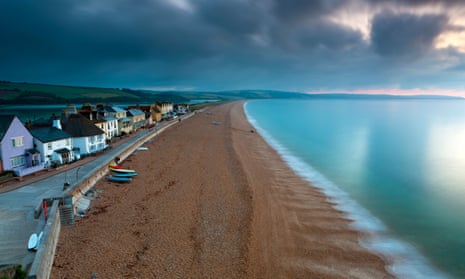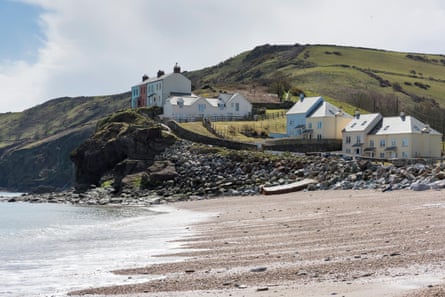On Slapton Sands: why my walk along Devon’s coast was a journey through time

A lot has happened in this little corner of the UK – discovery of early man, regal holidays, war disaster, humpback whale visits – all of which enrich the experience of taking this route
At least once in your life travel down from Strete towards Torcross village and lower your gaze over the shingle ridge that separates the freshwater of Slapton Ley from the pebbled beach of Slapton Sands.
Turn to the sea and look out across the open water of Start Bay where, in March 2017, a humpback whale hung around for nearly six weeks, inspiring amazement in the crowds it drew in day after day. It’s where every summer, for a week some time in August or July, shoals of mackerel stream through the bay and a frenzy of white bait, fleeing the terror of the mackerel, choose a certain death instead of a life as prey and hurl themselves out of the water and onto the shore.
Turning south, you can walk along the coastline past Beesands to Hallsands where, in 1917, 24 houses fell into the sea – a village lost and a fall that still looms large in local memory, speaking to the unaccounted ecological cost, or so the story goes, of shingle dredged up from the bay in the 1890s and 1900s to support the construction of dockyards in Devonport. The expensive long tail of empire and extraction that now confronts the surrounding settlements, increasingly exposed to erratic weather patterns and escalating coastal erosion.
When you get towards the lighthouse at Start Point, watch which way the wind blows over the surface of the sea, and look out towards the Skerries, an underwater reef made of sand and shell that’s a favourite haunt of sea bass and plaice and, with them, local fishermen who through generations honed their skills here before venturing further afield across the Atlantic and towards the cod-rich waters off the coast of Newfoundland.
Looking out across this landscape, that whole great geopolitical story of who got to develop their economy and at whose expense, and who became the powerhouse of industry and who became the debtor, is just about discernible from here.
Through the 17th and 18th centuries, wool from Devon would be swapped in Portugal for Madeira wine, which would travel well across the ocean and fetch a high price in South America. That would be swapped for sugar and rum, produced on the back of enslaved African labour working plantations across the Caribbean, which would then be returned to England for a mighty profit or taken to North America for cod that was, in turn, brought back here.
My pulse slows and my breath deepens every time I see the view across this bay, and yours might, too, as you anticipate the walk along the coastal path from Slapton middle carpark to the lighthouse and back again – as great a route as any I know for transcending a sense of self. A time to think of the planetary timeline that we, between the school runs and the deadlines, also inhabit.
READ RELATED: The Best Amazon Prime Day Wellness Deals You Can Shop Early
The rocks along the bay were formed around four hundred million years ago. There are wave-cut platforms at Start Point that date back around 150,000 years which is as long ago as when homo sapiens might have started to talk. We came to Devon just over 40,000 years ago and in fact the oldest-known human remnant in Britain – a prehistoric jawbone – was found in a cave system in Torquay just 20 miles or so further up the coast. It’s now on display in the museum there.

That ridge at Slapton Ley lake was created by the sea pushing back in as the last ice age ended around 10,000 years ago. As the ice melted, the sea came back in, pushing the shingle up to where it is now and has been for around 3,000 years. The ridge dammed up the streams running off from the River Gara, creating the lake, which is now the largest freshwater expanse in the south-west of England.
In the 1830s, as compensation payments made to slave-owners following the abolition of slavery across the British Empire drove land purchases and the cult of second homes across South Devon, it became more fashionable to holiday by the sea. An inn was built here that would be styled by its most famous guest, Queen Victoria’s son and heir [later Edward VII], as the Royal Sands Hotel, selling exclusive fishing rights to the rudd, roach and perch of Slapton Ley until the second world war. In 1943, the 3,000 inhabitants of Start Bay were evacuated and its 30,000 acres commandeered for successive rehearsals of the D-Day landings. A minefield was laid all around the hotel to make the rehearsal more realistic, only to be detonated by a stray dog. It left the building in ruins and the poor dog dead. The rehearsals claimed the lives of 750 allied soldiers here on Slapton Sands before anyone had come within sight of the enemy.
I first washed up here with my then girlfriend on a May bank holiday in 2015. We parked on what was once the site of the Royal Sands Hotel and walked up the beach, ascending the steps at Torcross before heading around the cliff and down again. We went into the water somewhere near the limpet rocks and then carried on (by land again) as far as Beesands where we had a pint at the Cricket Inn and take-away chips from Britannia and then scrambled back over the rocks as the tide came in.
We enjoyed the day trip so much that when we came back to Devon the following February with a six-month baby, a new member of the team, we did it all again. Though there’s a bite to the sea at that time of year, we learnt that if you just went in, came out again, then went back in, came out again, then went back in – on that third go you could kick back a bit and bear it. You could linger there and get acquainted with that sharp sensation of the ocean’s winter chill as it thins the blood.
Later, however, there would come the reward of seeing a rainbow drifting towards us over the open water and towards the sea wall while we stood outside the Cricket Inn and drank a pint of beer. Just water and light and the movement of air, but we stand in the presence of something that feels just like a miracle.
Source: Health & wellbeing | The Guardian




